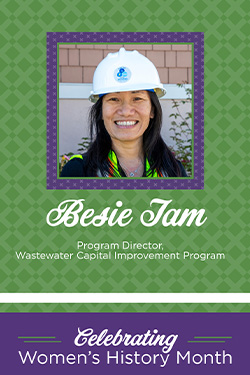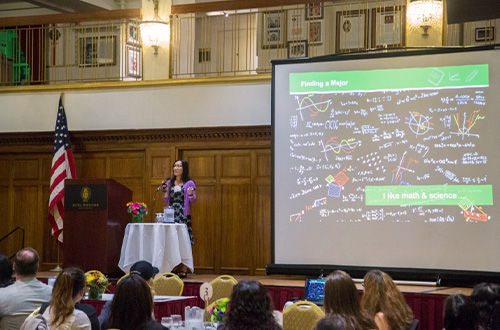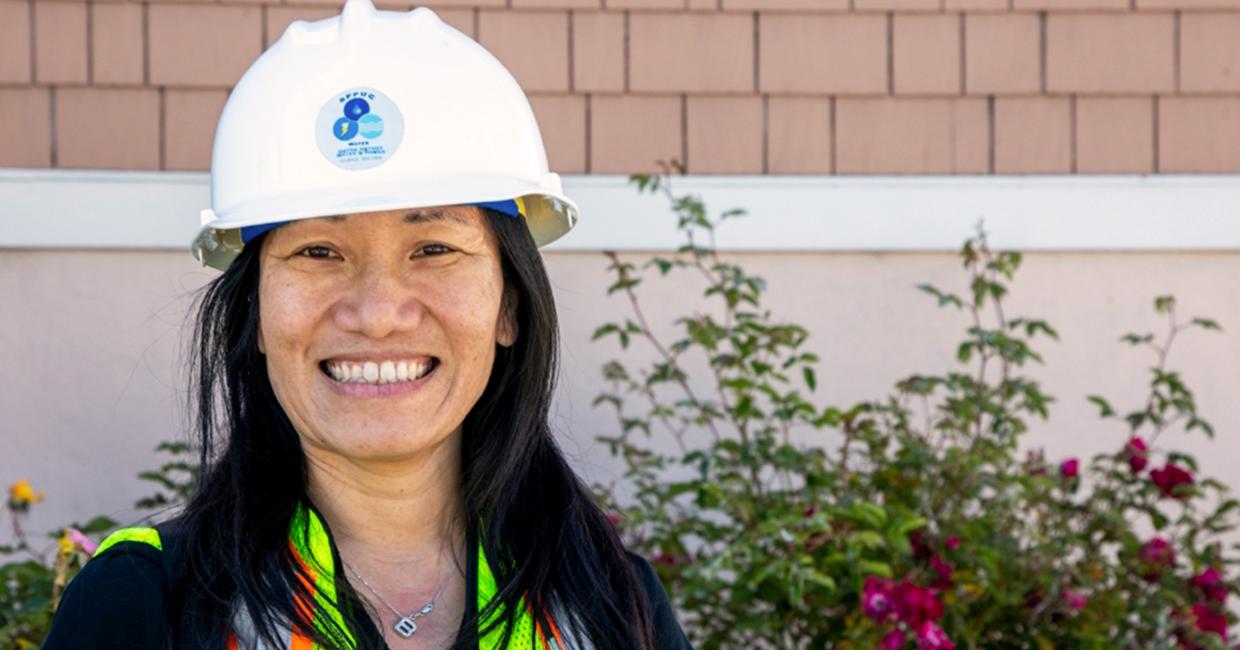For Bessie Tam, Program Director for the San Francisco Public Utilities Commission’s (SFPUC) Wastewater Capital Improvement Program, learning is a lifelong pursuit. Read along for an engaging interview in which she reviews her professional journey, recounts the most challenging parts of her career, shares her vision for the future of wastewater infrastructure, and touches upon the best ways in which women (and anyone, really) can start and flourish in an engineering industry career.
From the Beginning - Gaining Experience and Starting a Career in the Engineering Industry
What initially sparked your interest in engineering?
Funny enough, I didn’t know what “engineering” meant for a long time. Growing up, I liked science and math. Part of that was thanks to Charles Hubert, an excellent AP Physics teacher from my high school, and it was Mr. Hubert who suggested that I consider engineering as my college major.
He explained some of the different types of engineering, and by process of elimination on the types that most interested me, I selected Civil and Environmental Engineering. That conversation with my high school teacher was what initially sparked my interest in engineering.

Describe your professional journey to get where you are today, as Capital Program Director for SFPUC’s Wastewater Capital Improvement Program.
I’m very proud to be “homegrown” and went through the ranks with the City and County of San Francisco – starting with an engineering internship and am now a Program Director. But not only am I a City employee and a long-time resident of San Francisco – I’m also a ratepayer!
What progressed my development was interning with the City and County of San Francisco at the San Francisco International Airport (SFO), starting from my sophomore year of college. I was able to see how things worked in an office environment with the various teams and departments. I made a lot of friends, appreciated the mentors and peers, and greatly enjoyed my internship experience.
While in college, I also participated in the Society of Women Engineers, which offered job shadowing opportunities with professional engineers. I was able to job-shadow several engineers at the MWH office in Walnut Creek, CA, which gave me more perspective into the private side of the industry as well. These various experiences solidified my desire to pursue a career in engineering.
After graduating with a BS in Civil and Environmental Engineering, I got my first job at Dames and Moore, an engineering consulting firm in San Francisco. On the weekends, the offices were just as packed as during the week, and the workload was intense. While it was stressful at times, working alongside professionals who are technical experts at the regional or national levels, was very beneficial for my career growth. While at Dames & Moore, I progressed quickly from a staff engineer to a project manager role. Then sadly my mom got sick, and I realized that my work life balance needed to change…
I remembered enjoying my previous time with the City, and was fortunate to be hired back to SFO as a Junior Engineer. When 9/11 occurred, SFO operations had to cut down on operating expenses, and I was transferred to the SFPUC. With the SFPUC, I started working as an Assistant Engineer, then an Assistant Project Manager before becoming a Project Manager with the Watershed Roads, Fences & Bridges Program within the Water Enterprise. That was a lot of fun, being outside and working alongside watershed keepers in the Peninsula and Sunol areas.
Then, a 100-year storm hit San Francisco and caused inland flooding in many neighborhoods around the City in 2004, and the SFPUC redirected focus and initiated a $150M Wastewater Capital Program. By 2005, I was promoted to a Project Manager 2 on this new program and oversaw more than $70M of the projects. Over time, I worked my way up and became the Acting Senior Project Manager for the wastewater/collection system group, supervising eight other project managers who together collectively managed over $2B of wastewater capital projects.
In June 2023, I started my current role as the Program Director for the Wastewater Capital Improvements Programs, which was recently approved by the SFPUC Commission for ~$6B in capital upgrades over the next ten years. It has been rewarding going from a Senior Project Manager to Program Director, and I have really enjoyed the adventure so far. Throughout my career at the SFPUC, seeing so many strong leaders and their leadership over the years has been helpful and inspiring. It has motivated me to want to achieve that same level of work and inspiration in my own career.
Were there any people or single person earlier in your career that made a significant impact on your professional development?
I consider myself very lucky to have had excellent role models throughout my career. It’s so hard to choose just one! At the SFPUC alone, people like Karen Kubick, Manfred Wong, and Johanna Wong were supervisors and role models for me.
If I have to pick just one, the person who made a significant impact early in my career was Mr. Melvin Leong (Mel), the Deputy Director for Facility Operation Maintenance Division at SFO, who hired me as a student trainee at SFO. To me, he was the ultimate charismatic leader, who possessed both competence and warmth, and connected to staffs at all levels of the organization.
Even as a student trainee, Mel made me comfortable enough to walk into his office and talk to him about my work and challenges (yes, challenges as a student trainee!! LOL). My mentors, who also worked for Mel, often told me that I did not understand how unique Mel was as our manager. They were right – I did not fully appreciate his style, work ethics and impact at that time. Now, I realized the gold standard that he had so clearly demonstrated.
Launching the Sewer System Improvement Program (SSIP) - A Citywide Investment in the Future of San Francisco’s Wastewater System
What was it like to be part of the original development and launch of the SSIP?
The original development and launch of the Sewer System Improvement Program (SSIP) was so exciting! Everyone inside and outside of the agency wanted to be part of SSIP. The spirit was about creating something bigger than us, that we are going to be a family, and these ideas were reinforced by my leaders and peers which made it that much more exciting and rewarding.
What is your take on why it’s important for people to consider the importance of our sewer system?
I joke with student trainees that if engineers at Apple were worried about how to get rid of sewage, we would not have an iPhone today. The sewer system in San Francisco, like any other place in the world, is the bedrock of modern society. A well-functioning sewer system is an essential service that frees up people’s time and energy to do other things, and to live their lives and thrive.
It is also important to remember that working to protect and upgrade the sewer system ensures the health and safety of the community at large. It protects water quality for the environment and is fundamental to the way we live today.

What is your vision for the future of San Francisco’s wastewater infrastructure?
My vision is for San Franciscans and others across the nation to appreciate our COMBINED sewer system – how we treat both sewage and stormwater in our system. The combined sewer system posts unique advantages and challenges – see Our Sewer System and Storms. In my conversations with San Franciscans, I haven’t had a problem explaining to residents and businesses about the importance of our wastewater projects. However, the “combined sewer system” operates differently from a “separate sewer system” found in many other parts of the country, and we need to do a better job of explaining how these differences pose unique challenges to San Francisco.
When the Going Gets Tough, Take Some Initiative!
Can you highlight a specific project or accomplishment in your career that you are particularly proud of? How did this contribute to your growth as an engineer?
Everything I learned, I learned from the “North Shore to Channel Force Main Project”. This project involved constructing a new force main (sewer pipe) from The Embarcadero across Market Street and Mission Street and ending in front of the Rincon Center downtown. This was the first project since the 1980’s that involved constructing a new pipe in downtown San Francisco.
Through this project I learned so much. To construct this project, we coordinated with over 10 private utilities, SFMTA, businesses, the Federal Reserve, local elected officials, and more! The project team, our contractor, and other City agencies were incredibly hard working through all the ups and downs. We all had one goal – to construct this important sewer line conveying the combined sewage for the northeastern segment of San Francisco to the wastewater treatment plant in the southeast part of the City, protecting public health and the water quality of the Bay.
Through this project, I learned that City departments, residents, businesses, developers, and politicians can accomplish anything when we work together with a clear purpose and goal.
What advice do you have for young women pursuing careers in engineering today?
First, I would say, I encourage everyone to consider a career in engineering. To me, engineers are problem solvers who use technology and science to solve problems. I think what makes a good engineer are curious and open-minded people with an interest in solving problems, and that mindset will help anyone in their engineering career.
I learned in my career that effective communication is very important. Most solutions will require collaboration with other teams and people, with many projects being a group effort. I would tell young professionals interested in pursuing a career in engineering to value effective teamwork and communication in addition to the technical side of their studies. That’s one of the reasons why I really like engineering - there's always a problem to be solved. There's always a common goal that you can work towards together.
What positive trends or improvements have you seen change in the engineering landscape for women over the years? How can the industry further promote the DEI, the inclusivity that we were talking about earlier, particularly for women?
I can confidently say I see a lot of women in engineering, project management, and leadership positions right here at the SFPUC. That's a big change I have observed over my 20 plus years of working in the industry. San Francisco is very progressive in the sense that we encourage participation from everyone. We have a lot of guardrails in terms of training, diversity, and providing an inclusive environment for staff to work in.
When I saw women in leadership roles, it was always very encouraging to me. Sometimes just by seeing somebody in a leadership position, it allows one to think that one day I can also be there. I think this originates with mentorship opportunities. Spending time with a student trainee, showing them the technical side of work, while also explaining the importance of team collaboration is crucial.


